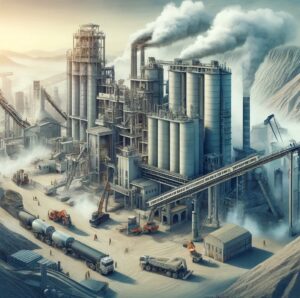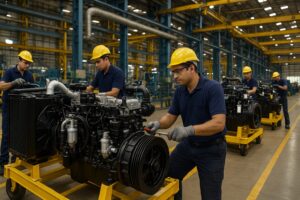🏗️ Business Models and Core Segments
Sanghi Industries, primarily based in Gujarat, focuses on cement and clinker production with integrated facilities encompassing limestone mines, a captive power plant, and a sea-link jetty for exports. The business model leans heavily on operational efficiencies in its single-location strategy. It lacks the geographic and product diversification seen in its larger peers.
UltraTech Cement, India’s largest cement producer (a subsidiary of the Aditya Birla Group), has a pan-India presence with operations across 22 integrated plants and a diversified product mix including grey cement, white cement, and ready-mix concrete. Its scale and vertical integration give it a cost leadership position.
Ambuja Cements and ACC Ltd, now both under the Adani Group, operate as separate entities but share strategic synergies. They boast widespread distribution, retail reach, and significant emphasis on green cement and sustainable manufacturing. Their business models increasingly align under a combined operational umbrella.
Shree Cement champions operational efficiency and cost minimization, focusing on energy conservation and lean cost structures. Its geographic reach spans northern and eastern India, and its decentralised model has served well in delivering above-average margins.
Dalmia Bharat, another major integrated player, emphasizes cement varieties including oil well cement and blended cement, with a push towards sustainability and carbon neutrality. It focuses heavily on southern and eastern markets but is steadily expanding westward.
🌍 Geographic Reach and Distribution Networks
Sanghi’s distribution is largely centered in western India, with Gujarat being the core market. Its limited pan-India logistics and dependence on one plant pose a competitive disadvantage in penetrating deeper into the national market.
In contrast, UltraTech, with more than 50,000 channel partners, has the deepest distribution network in India. Shree Cement, ACC, and Ambuja also have vast distribution setups with retail-friendly approaches. Dalmia Bharat’s network, while not as expansive as UltraTech’s, is robust and growing quickly with recent capacity expansions.
🚧 Capacity and Utilization
As of FY2024:
-
Sanghi Industries: Approx. 6.6 MTPA capacity.
-
UltraTech Cement: Over 137 MTPA, with expansion plans to 160+ MTPA.
-
Ambuja + ACC (combined): Nearly 67 MTPA, with investments underway for capacity ramp-up.
-
Shree Cement: ~56 MTPA, targeting 80 MTPA by FY2028.
-
Dalmia Bharat: ~45 MTPA, with aims to reach 75 MTPA by 2030.
The disparity in installed capacity underscores Sanghi’s comparatively niche positioning. While its utilization rates are competitive in its core geography, it lacks the scalability and buffer that larger players possess.
📊 Financial Performance Snapshot (FY2024)
Sourced from recent quarterly filings and annual reports:
-
UltraTech: Revenue ₹74,000+ Cr, PAT ₹6,800+ Cr, EBITDA margin ~21%.
-
ACC: Revenue ₹18,000+ Cr, PAT ₹1,000+ Cr, EBITDA margin ~16%.
-
Ambuja: Revenue ₹34,000+ Cr, PAT ₹2,800+ Cr, EBITDA margin ~18%.
-
Shree Cement: Revenue ₹20,000+ Cr, PAT ₹1,200+ Cr, EBITDA margin ~20%.
-
Dalmia Bharat: Revenue ₹13,000+ Cr, PAT ₹850+ Cr, EBITDA margin ~19%.
-
Sanghi Industries: Revenue ~₹1,500 Cr, PAT still negative or marginally positive, EBITDA margin ~10–12%.
Sanghi operates at a significantly smaller financial scale, with thin margins and higher fixed costs per ton. However, post-Adani acquisition (in 2023), the turnaround initiatives have begun impacting operational metrics positively.
🧱 Strategic Developments and Investments
A major development was Adani Group’s acquisition of Sanghi Industries, aiming to consolidate ACC and Ambuja’s west coast capacities. Sanghi’s strategic location with a captive port adds significant logistical leverage for exports and coastal distribution, aligning with Adani’s infra-heavy strategy.
UltraTech continues its aggressive expansion through brownfield and greenfield projects and inorganic growth. Shree and Dalmia have focused on organic growth and sustainability-centric capex, while ACC and Ambuja are undergoing post-acquisition realignment to optimize capacity and logistics under the Adani umbrella.
♻️ Sustainability and Innovation
Larger players have entrenched ESG initiatives:
-
UltraTech: Committed to net-zero by 2050, with investments in WHRS (Waste Heat Recovery Systems), AFR (Alternative Fuels and Raw materials), and carbon capture.
-
Ambuja & ACC: Strong ESG focus under Adani, targeting green cement and extensive circular economy practices.
-
Shree Cement: Pioneer in WHRS, ranked among the lowest energy-consuming cement producers globally.
-
Dalmia Bharat: Targets carbon negativity by 2040, with major investments in alternative fuels.
Sanghi lags in ESG disclosures and frameworks, but post-Adani takeover, sustainability and compliance metrics are being enhanced, especially with WHRS and AFR in focus.
📦 Customers and End Markets
All companies primarily cater to the real estate, infrastructure, and industrial sectors. UltraTech, ACC, and Ambuja benefit from national infrastructure projects and central procurement agencies. Shree and Dalmia capitalize on regional demand from housing and roads.
Sanghi, with its limited market scope, is more susceptible to regional economic cycles. However, the port facility allows it to tap export markets like the Middle East and East Africa—giving it a unique albeit niche export edge.
💰 Shareholding and Market Capitalization (as of August 2025)
-
Sanghi Industries: Market cap ~₹3,200 Cr | Promoter: Adani Group (74%)
-
UltraTech Cement: Market cap ~₹2.8 lakh Cr | Promoter: Aditya Birla Group (~59%)
-
ACC: Market cap ~₹44,000 Cr | Promoter: Adani Group
-
Ambuja Cements: Market cap ~₹85,000 Cr | Promoter: Adani Group
-
Shree Cement: Market cap ~₹90,000 Cr | Promoter: Bangur family
-
Dalmia Bharat: Market cap ~₹42,000 Cr | Promoter: Dalmia family
Sanghi’s low market cap reflects its size and earnings limitations. However, being part of the Adani ecosystem may enhance its access to capital and operational synergies.
⚖️ Strengths and Weaknesses Overview
Sanghi Industries
-
Strengths: Strategic location with sea port, vertical integration, Adani ownership support.
-
Weaknesses: Low capacity, high regional dependence, weak financials, limited ESG integration.
UltraTech
-
Strengths: Scale, brand, distribution, lowest costs, strong ESG roadmap.
-
Weaknesses: Integration challenges with acquisitions, regulatory risks due to size.
ACC & Ambuja
-
Strengths: Brand legacy, wide footprint, Adani-led efficiency plans, green cement leadership.
-
Weaknesses: Transition friction under new ownership, competition from group overlaps.
Shree Cement
-
Strengths: Operational efficiency, excellent cost control, strong return ratios.
-
Weaknesses: Less diversified product-wise, slower to scale pan-India.
Dalmia Bharat
-
Strengths: ESG leadership, product innovation, east/south India dominance.
-
Weaknesses: Regional revenue concentration, moderate distribution reach nationally.
🔍 Conclusion
Sanghi Industries, while modest in scale, is not without strategic importance. With Adani’s ownership, it could serve as a linchpin for western India consolidation under the ACC-Ambuja umbrella. However, when compared to the likes of UltraTech or Shree Cement, Sanghi remains a regional player transitioning toward a larger role.
Its future depends on how effectively it scales operations, improves margins, and aligns with sustainability expectations. In contrast, peers are focused on capacity expansion, ESG benchmarks, and technological adoption, reinforcing their leadership positions in India’s cement landscape.




